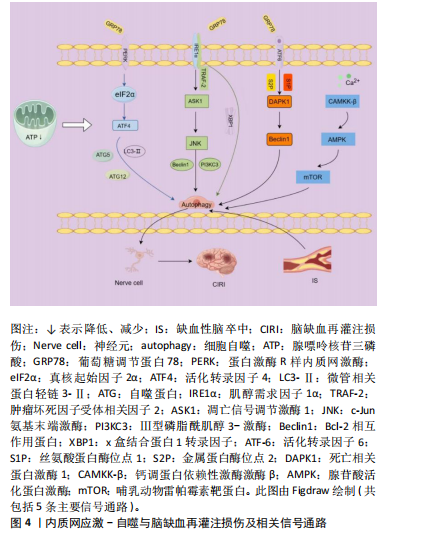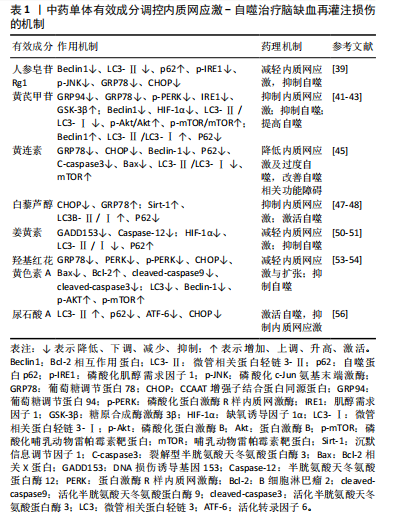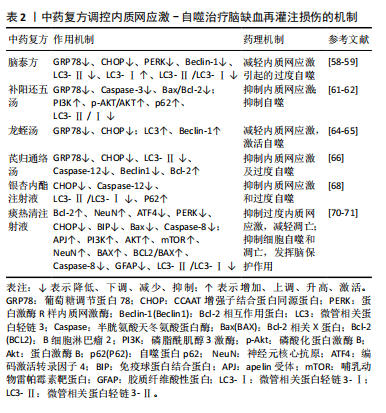[1] SUN L, ZHAO Z, GUO J, et al. Mitochondrial transplantation confers protection against the effects of isc hemic stroke by repressing microglial pyroptosis and promoting neurogenesis. Neural Regen Res. 2024;19(6):1325-1335.
[2] 《中国脑卒中防治报告2021》编写组, 王陇德. 《中国脑卒中防治报告2021》概要[J]. 中国脑血管病杂志,2023,20(11):783-793.
[3] MA Q, LI R, WANG L, et al. Temporal trend and attributable risk factors of stroke burden in China, 1990–2019: an analysis for the Global Burden of Disease Study 2019. Lancet Public Health. 2021;6(12): e897-e906.
[4] ZHAO Y, ZHANG X, CHEN X, et al. Neuronal injuries in cerebral infarction and ischemic stroke: From mechanisms to treatment (Review). Int J Mol Med. 2022;49(2):15.
[5] 曹晓慧,赵敏菡,霍瑞卿,等.化浊解毒活血通络方对脑缺血再灌注损伤大鼠氧化损伤和炎症因子的影响[J]. 中华中医药杂志,2024, 39(4):1979-1984.
[6] 丁元庆,陈哲,唐赛雪.《内经》对构建中风病机理论的作用与影响[J].山东中医药大学学报,2020,44(4):344-349+343.
[7] 刘向哲,宋艳芳,冉春龙,等.基于八纲虚实辨证分期序贯治疗缺血性中风探讨[J].中国实验方剂学杂志,2024,30(9):186-192.
[8] LI XH, YIN FT, ZHOU XH, et al. The Signaling Pathways and Targets of Natural Compounds from Traditional Chinese Medicine in Treating Ischemic Stroke. Molecules. 2022;27(10):3099.
[9] CHEN X, SHI C, HE M, et al. Endoplasmic reticulum stress: molecular mechanism and therapeutic targets. Signal Transduct Target Ther. 2023;8(1):352.
[10] KAPUY O. Mechanism of Decision Making between Autophagy and Apoptosis Induction upon Endoplasmic Reticulum Stress. Int J Mol Sci. 2024;25(8):4368.
[11] 季禾,栗延伟,谭军,等. 腺苷预处理对脑缺血再灌注损伤大鼠脑组织中CCAAT/增强子结合蛋白同源蛋白表达的影响[J]. 新乡医学院学报,2023,40(2):101-106.
[12] XUE X, LI F, CAI M, et al. Interactions between Endoplasmic Reticulum Stress and Autophagy: Implications for Apoptosis and Neuroplasticity-Related Proteins in Palmitic Acid-Treated Prefrontal Cells. Neural Plast. 2021;2021:8851327.
[13] 赵千增,赵振群,刘万林. 激素性股骨头缺血坏死过程中内质网应激调控自噬与凋亡的作用 [J]. 中国组织工程研究,2021,25(29): 4685-4690.
[14] CAO W, LI J, YANG K, et al. An overview of autophagy: Mechanism, regulation and research progress. Bull Cancer. 2021;108(3):304-322.
[15] 石晓花,莽靖,徐忠信. 脑缺血再灌注损伤细胞死亡模式的研究进展[J]. 吉林大学学报(医学版),2022,48(6):1635-1643.
[16] WANG L, KLIONSKY DJ, SHEN HM. The emerging mechanisms and functions of microautophagy. Nat Rev Mol Cell Biol. 2023;24(3): 186-203.
[17] WANG L, DAI M, GE Y, et al. EGCG protects the mouse brain against cerebral ischemia/reperfusion injury by suppressing autophagy via the AKT/AMPK/mTOR phosphorylation pathway. Front Pharmacol. 2022;13:921394.
[18] YANG Z, WANG L, HU Y, et al. Butorphanol protects PC12 cells against OGD/R-induced inflammation and apoptosis. Mol Med Rep. 2020; 22(3):1969-1975.
[19] 赵楠,肖雪,曹兰秀. 内质网应激在细胞自噬调控中的作用及其分子机制[J]. 生理科学进展,2023,54(5):426-432.
[20] QI Z, CHEN L. Endoplasmic Reticulum Stress and Autophagy. Adv Exp Med Biol. 2019;1206:167-177.
[21] 徐倩,许银丰,杨杰杰,等. 内质网应激与细胞自噬的关系[J]. 中国细胞生物学学报,2020,42(8):1489-1500.
[22] MONCAN M, MNICH K, BLOMME A, et al. Regulation of lipid metabolism by the unfolded protein response. J Cell Mol Med. 2021; 25(3):1359-1370.
[23] CYBULSKY AV. Endoplasmic reticulum stress, the unfolded protein response and autophagy in kidney diseases. Nat Rev Nephrol. 2017; 13(11):681-696.
[24] YU C, ZHANG Z, XIAO L, et al. IRE1alpha pathway: A potential bone metabolism mediator. Cell Prolif. 2024;57(10):e13654.
[25] 马炜祥,张婷婷,崔凤针,等. 内质网应激关键分子ATF6α在癌症中作用的研究进展[J]. 华中科技大学学报(医学版),2022,51(2): 241-246+253.
[26] ZHANG Q, LIU G, LIU R, et al. Dual role of endoplasmic reticulum stress-ATF-6 activation in autophagy and apoptosis induced by cyclic stretch in myoblast. Apoptosis. 2023;28(5-6):796-809.
[27] 庞欣欣,邢玉凤,彭紫凝,等.内质网应激与自噬交互作用在糖尿病肾病发病中的作用[J]. 生理科学进展,2020,51(6):464-468.
[28] NUNEZ-OLVERA SI, GALLARDO-RINCON D, PUENTE-RIVERA J, et al. Autophagy Machinery as a Promising Therapeutic Target in Endometrial Cancer. Front Oncol. 2019;9:1326.
[29] Di FAZIO P, MATROOD S. Targeting autophagy in liver cancer. Transl Gastroenterol Hepatol. 2018;3:39.
[30] DIAO F, JIANG C, SUN Y, et al. Porcine reproductive and respiratory syndrome virus infection triggers autophagy via ER stress-induced calcium signaling to facilitate virus replication. PLoS Pathog. 2023; 19(3):e1011295.
[31] 刘前程,刘鑫,邓湘雨,等. 健脾益气方干预内质网应激IRE1α-XBP1通路诱导腹膜间皮细胞自噬防治PF的机制[J]. 中国老年学杂志,2024,44(7):1642-1647.
[32] 王笠. 钒通过内质网应激介导的PERK/ATF4/CHOP信号通路诱导鸭肾小管上皮细胞自噬[D]. 南昌:江西农业大学,2023.
[33] 任真奎. LncRNA LOC103692885/miR-187-3p/Seipin轴调控内质网应激、自噬在脑缺血再灌注损伤中的分子机制研究[D]. 贵阳:贵州医科大学,2021.
[34] AHSAN A, ZHENG YR, WU XL, et al. Urolithin A-activated autophagy but not mitophagy protects against ischemic neuronal injury by inhibiting ER stress in vitro and in vivo. CNS Neurosci Ther. 2019;25(9):976-986.
[35] ZHANG T, LU D, YANG W, et al. HMG-CoA Reductase Inhibitors Relieve Endoplasmic Reticulum Stress by Autophagy Inhibition in Rats With Permanent Brain Ischemia. Front Neurosci. 2018;12:405.
[36] 杨楠,丁锚,闫峰,等.远隔缺血预适应对脑缺血再灌注损伤大鼠缺血半暗带区PERK/p-eIF2α通路及自噬的影响[J]. 首都医科大学学报,2021,42(2):225-231.
[37] LV S, GENG X, YUN HJ, et al. Phenothiazines reduced autophagy in ischemic stroke through endoplasmic reticulum (ER) stress-associated PERK-eIF2alpha pathway. Exp Neurol. 2023;369:114524.
[38] TIAN G, LI J, ZHOU L. Ginsenoside Rg1 regulates autophagy and endoplasmic reticulum stress via the AMPK/mTOR and PERK/ATF4/CHOP pathways to alleviate alcohol‑induced myocardial injury. Int J Mol Med. 2023;52(1):56.
[39] 李雨晴,魏梁丽,袁雨琪,等. 人参皂苷Rg_1通过IRE1-JNK-CHOP通路抑制自噬改善OGD/R诱导的PC12细胞损伤[J]. 中国中药杂志, 2024,49(10):2745-2753.
[40] ZHANG X, QU H, YANG T, et al. Astragaloside IV attenuate MI-induced myocardial fibrosis and cardiac remodeling by inhibiting ROS/caspase-1/GSDMD signaling pathway. Cell Cycle. 2022;21(21):2309-2322.
[41] 蔡建航. 黄芪甲苷通过抑制内质网应激阻止mPTP开放保护PC12细胞[D]. 唐山:华北理工大学,2018.
[42] 龙佳欣,田梦芝,陈笑一,等. 黄芪甲苷介导Akt/mTOR/HIF-1α通路调控氧糖剥夺PC12细胞自噬的机制研究[J]. 中国中药杂志, 2023,48(19):5271-5277.
[43] 张怡,张彐宁,周晓红,等. 黄芪甲苷缓解大脑中动脉阻塞/再灌注大鼠脑组织损伤的作用及机制[J]. 时珍国医国药,2021,32(11): 2636-2639.
[44] ZHU C, LI K, PENG XX, et al. Berberine a traditional Chinese drug repurposing: Its actions in inflammation-associated ulcerative colitis and cancer therapy. Front Immunol. 2022;13:1083788.
[45] 谢鹏. 黄连素通过抑制内质网应激和自噬对PC12细胞OGD/R损伤的保护作用及机制研究[D]. 贵阳:贵州医科大学,2020.
[46] KATILA N, DUWA R, BHURTEL S, et al. Enhancement of blood-brain barrier penetration and the neuroprotective effect of resveratrol. J Control Release. 2022;346:1-19.
[47] 郭静洁,张引红. 运动和白藜芦醇预处理对脑缺血再灌注大鼠脑损伤及内质网应激的影响[J]. 护理研究,2023,37(16):2965-2970.
[48] 何琪. 白藜芦醇通过增强Sirt-1诱导的自噬活性抑制NLRP3炎性复合体活化减轻脑缺血再灌注损伤[D]. 重庆:重庆医科大学,2018.
[49] FAN F, LEI M. Mechanisms Underlying Curcumin-Induced Neuroprotection in Cerebral Ischemia. Front Pharmacol. 2022;13: 893118.
[50] 朱海英,孙红玉,冯光坤,等. 姜黄素抑制大鼠脑缺血再灌注损伤内质网应激的研究[J]. 中华老年心脑血管病杂志,2015,17(4):416-420.
[51] 侯杨. 姜黄素对缺血再灌注损伤神经元细胞的保护机制研究[D]. 沈阳:中国医科大学,2019.
[52] YU L, JIN Z, LI M, et al. Protective potential of hydroxysafflor yellow A in cerebral ischemia and reperfusion injury:An overview of evidence from experimental studies. Front Pharmacol. 2022;13:1063035.
[53] 张云. 羟基红花黄色素A抑制GRP78/PERK/CHOP信号通路保护脑缺血再灌注损伤模型大鼠[D]. 合肥:安徽中医药大学,2023.
[54] 杨光. 羟基红花黄色素A保护氧糖剥夺/复糖复氧损伤大鼠脑微血管内皮细胞的自噬途径研究[D]. 合肥:安徽中医药大学,2017.
[55] LIN IC, WU JY, FANG CY, et al. Absorption and Metabolism of Urolithin A and Ellagic Acid in Mice and Their Cytotoxicity in Human Colorectal Cancer Cells. Evid Based Complement Alternat Med. 2023; 2023:8264716.
[56] AHSAN A . 尿石酸A及番茄碱的抗缺血性神经损伤作用及自噬相关机制研究[D]. 杭州:浙江大学,2020.
[57] 宋洋. 基于内质网应激介导的细胞自噬探究脑泰方对脑缺血再灌注损伤的神经保护机制[D]. 长沙:湖南中医药大学,2023.
[58] 宋洋,葛金文,陈瑶. 脑泰方对脑缺血/再灌注大鼠的神经保护作用 [J]. 中成药,2023,45(3):924-929.
[59] 宋洋,陈瑶,胡立娟,等. 脑泰方含药血清对缺氧缺糖/复氧PC12细胞损伤的保护作用 [J]. 湖南中医药大学学报,2023,43(5):814-821.
[60] 叶才博,陈祥宇,杜杰勇,等. 基于miR-665/DRAM1信号介导的自噬探讨补阳还五汤延缓血管衰老的作用[J]. 南京中医药大学学报, 2024,40(4):369-378.
[61] 侯晓婵. 基于PERK通路探讨补阳还五汤抑制内质网应激介导的细胞凋亡减轻脑缺血再灌注损伤[D]. 承德:承德医学院,2021.
[62] 单玉栋,赵艳萌,靳晓飞,等. 补阳还五汤通过PI3K/AKT通路调控自噬抗大鼠脑缺血/再灌注损伤的作用[J]. 中国药理学通报,2023, 39(2):386-391.
[63] 李南方,陈永斌,刘启华,等. 龙蛭汤对脑缺血再灌注损伤大鼠血管新生的促进作用[J]. 辽宁中医杂志,2022,49(9):195-198+227.
[64] 李南方. 基于内质网应激探讨龙蛭汤促进脑缺血再灌注损伤大鼠血管新生的作用机制[D]. 南宁:广西医科大学,2020.
[65] 邹玲. 基于细胞自噬探讨龙蛭汤促进脑缺血再灌注损伤大鼠血管新生的作用机制[D]. 南宁:广西医科大学, 2019.
[66] 周围,胡立丹,孔凡盛,等. 芪归通络方联合针刺改善卒中后偏瘫的临床观察及对内质网应激-自噬的影响 [J]. 中华中医药学刊, 2023,41(7):89-93.
[67] 赵乐,陈琳,蒋美玲,等.活络效灵丹方剂联合银杏内酯注射液治疗缺血性脑卒中恢复期瘀血阻络证疗效研究[J].中国药师,2024, 27(1):125-134.
[68] 兰新新,曹磊,王林晓,等. 银杏内酯注射液抑制脑缺血再灌注模型大鼠内质网应激和自噬 [J]. 中国临床药理学与治疗学,2015, 20(6):634-639.
[69] 杨万枝. 基于属性层次模型的痰热清注射液用药合理性评价[J].中国新药与临床杂志,2024,43(1):70-74..
[70] 李莎莎. 基于内质网应激通路研究痰热清注射液对急性脑梗死大鼠的治疗机制[D]. 北京:北京中医药大学,2021.
[71] 李中浩. 痰热清注射液对脑梗死后apelin信号通路及细胞凋亡和自噬的影响[D].北京:北京中医药大学,2021.
|



